画廊展出|马里安的绘画真相,卡迈勒 · 梅隆赫画廊正在展出
![]() {{newsData.publisher_name}}
{{newsData.update_time}}
浏览:{{newsData.view_count}}
{{newsData.publisher_name}}
{{newsData.update_time}}
浏览:{{newsData.view_count}}
来源 | {{newsData.source}} 作者 | {{newsData.author}}

展览“马里安,一种绘画真相”现场,卡迈勒 · 梅隆赫画廊,2022Photo. archives kamel mennourCourtesy The Estate of Maryan and kamel mennour, Paris

地址:47 rue Saint-André-des-Arts, Paris 6致谢Flak画廊和吕卡 · 拉通画廊借出的部落艺术作品
平查斯 · 伯恩斯坦(Pinchas Burstein)来自一个波兰犹太家庭,1927年出生于克拉科夫市东南的一座小城。二战后他是全家唯一的幸存者,这场20世纪最具破坏性的战争注定要给他烙下沉重的伤痛。他后来以马里安 · S · 马里安(Maryan S. Maryan)之名为世人所知晓,留下的一系列作品色彩强烈,风格突出,常常被视为一面哈哈镜,折射了他自己的个人经历。然而,他的作品并不是向过去的一种复仇,他总是拒绝以集中营的经历作为解读其创作的唯一视角。“人们写的关于我的大部分内容都是不实的”,他在去世前曾写道。从1949年他在耶路撒冷的第一次展览直到1977年他在纽约突然离世,马里安始终将艺术作为一种必需的宣泄方式。艺术于他而言不是为了表达仇恨,而更多地是体现了洞察力。他的画与其说是见证了自己的过去,不如说是描绘了人类残酷而又扣人心弦的命运。尽管他被同辈视为“新具象主义之父”,其作品却长期被忽视。马里安既不是将艺术作为见证的人,也不是疯狂的艺术家:他的疯狂仅仅只是表现在笔下。马里安既不是激进分子,也不是要为某一立场发声,他只是试图展示他所经历、所感知的世界,而这多半就是世界真实的样子。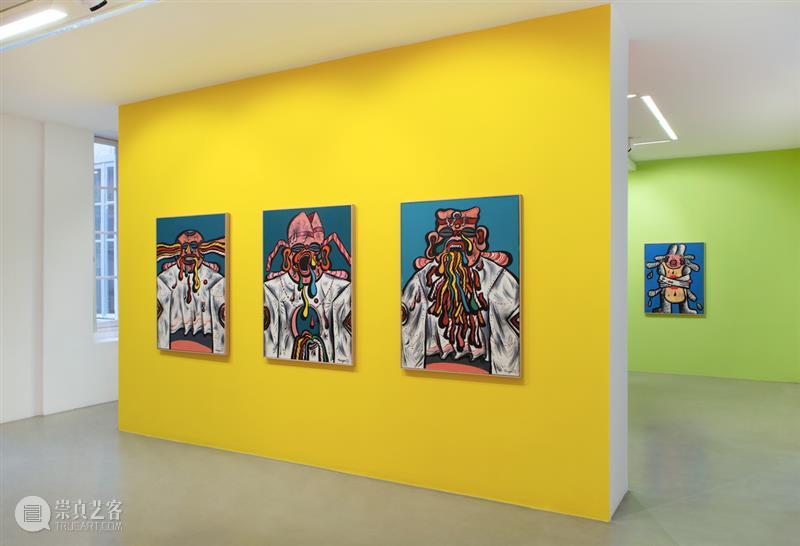
展览“马里安,一种绘画真相”现场,卡迈勒 · 梅隆赫画廊,2022Photo. archives kamel mennourCourtesy The Estate of Maryan and kamel mennour, Paris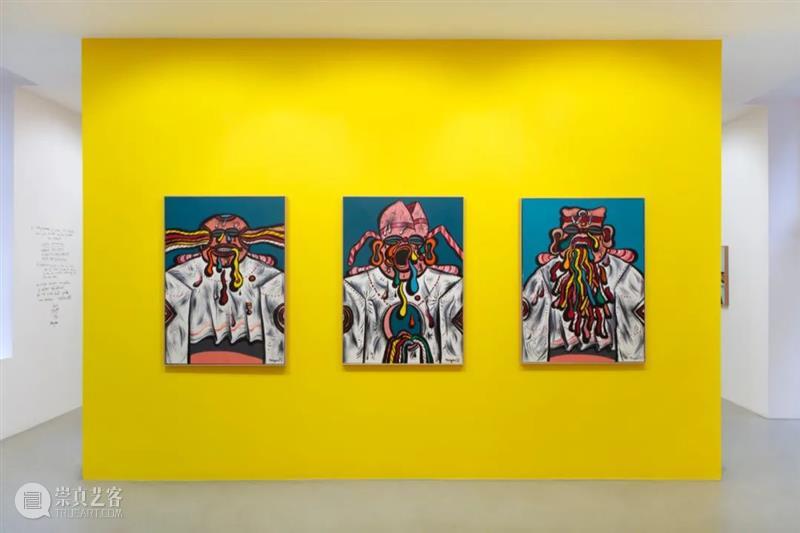
展览“马里安,一种绘画真相”现场,卡迈勒 · 梅隆赫画廊,2022Photo. archives kamel mennourCourtesy The Estate of Maryan and kamel mennour, Paris1950年代,他住在抽象主义盛行的巴黎,与从巴黎画派到Cobra艺术运动的众多艺术家来往频繁。他在与他们的接触过程中,尤其是追随着法国画家让-米歇尔 · 阿特兰和墨西哥画家鲁菲诺 · 塔马约的足迹,创作出了我们可以称之为“具象表现主义”的画作。1961年,马蒂亚斯 · 费尔斯画廊组织的展览“新具象”,展示了当时在欧洲兴起的回归具象绘画潮流。马里安的作品与卡雷尔 · 阿佩尔、弗朗西斯 · 培根、阿尔贝托 · 贾科梅蒂以及让 · 杜布菲的作品一同参加了这次展出。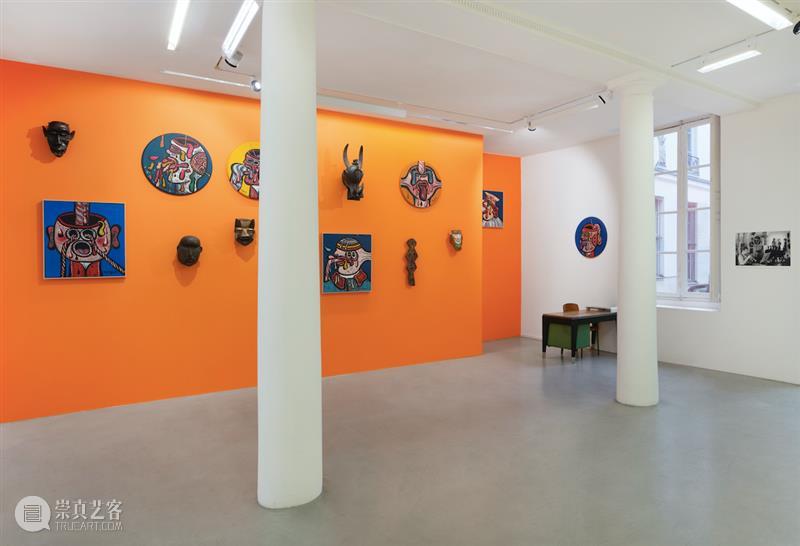
展览“马里安,一种绘画真相”现场,卡迈勒 · 梅隆赫画廊,2022Photo. archives kamel mennourCourtesy The Estate of Maryan and kamel mennour, Paris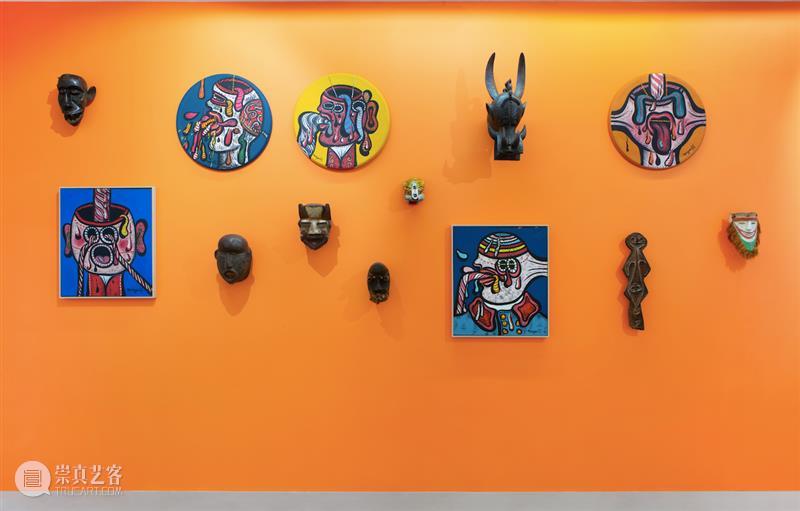
展览“马里安,一种绘画真相”现场,卡迈勒 · 梅隆赫画廊,2022Photo. archives kamel mennourCourtesy The Estate of Maryan and kamel mennour, Paris马里安于1962年前往美国并于1969年获得美国公民身份,由此走向一个新的创作时期,而美式生活——消费主义的生活方式对其影响巨大。抽象表现主义退出艺术舞台,波普艺术的时代开启。马里安对此密切关注,从细节中观察到这一艺术运动不仅是发生在文化领域而正在成为真正的社会现象。这一认知将推动他创作范式的重大转变。纽约的生活让马里安感到如鱼得水,他发展出的个人绘画风格受到从流行文化到民俗文化等多重影响。这一兼容并蓄的态度将帮助他打造出极具辨识度的“马里安式”风格。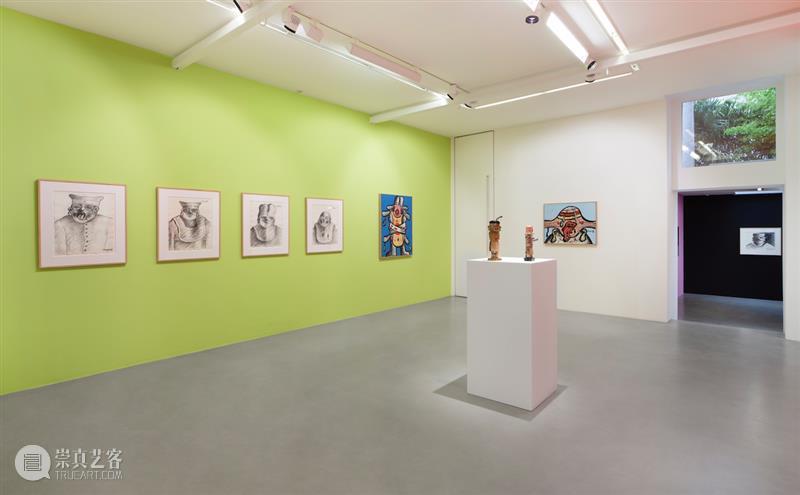
展览“马里安,一种绘画真相”现场,卡迈勒 · 梅隆赫画廊,2022Photo. archives kamel mennourCourtesy The Estate of Maryan and kamel mennour, Paris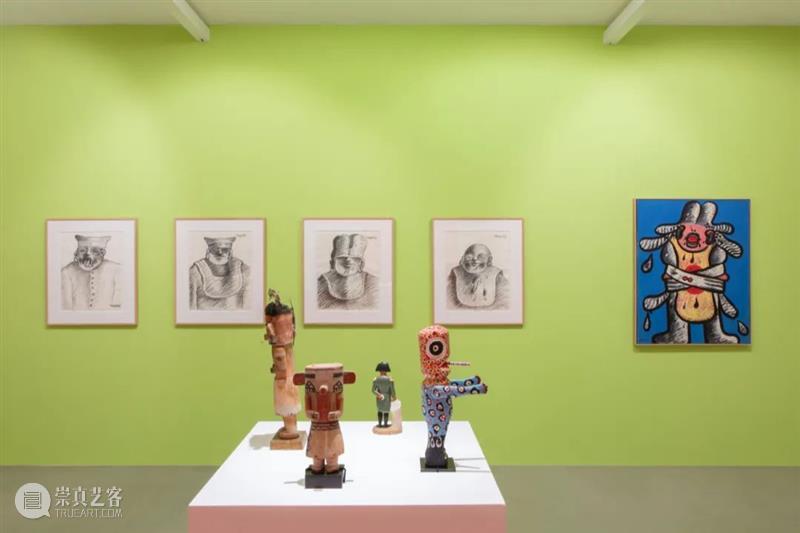
展览“马里安,一种绘画真相”现场,卡迈勒 · 梅隆赫画廊,2022Photo. archives kamel mennourCourtesy The Estate of Maryan and kamel mennour, Paris这一时期的画作往往没有标题,刻画了一个个身着怪诞服装的孤独的人物,似乎在把他们放到舞台的聚光灯下展示。尽管这些人物大部分是匿名且身份不明的,但仍然可以从一些戴着巨大眼镜的人物中看出艺术家自画像的影子。他笔下的众多人物包括美国三K党的成员(这个奉行白人至上主义的恐怖主义组织在1960年代有死灰复燃的趋势),穿西装打领带的华尔街银行家或商人,他们嘴里塞满糖果棒,脸上堆着笑或写满嘲讽。他们中有些人戴着旧时老师惩罚调皮学生用的尖角帽,另一些人的帽边下垂到了眼睛:他们的帽子有圆有尖,有的凹凸,有的变形,有的过于巨大,让人隐隐联想到西班牙塞维利亚圣周期间参加宗教游行的忏悔者。这些人物也让人想起马里安很欣赏的委拉斯开兹、弗朗西斯科·德·戈雅和弗兰斯·哈尔斯的作品。虽然这些作品表达了一种对社会的尖锐讽刺,但它们似乎更是源于艺术家的日常生活以及让人意想不到的审美冲击,例如伪装成拿破仑的系列人物(基于一位收藏家朋友送给他的拿破仑小雕像),又比如他在游历西班牙之后画的斗牛士面对公牛的斗兽场景。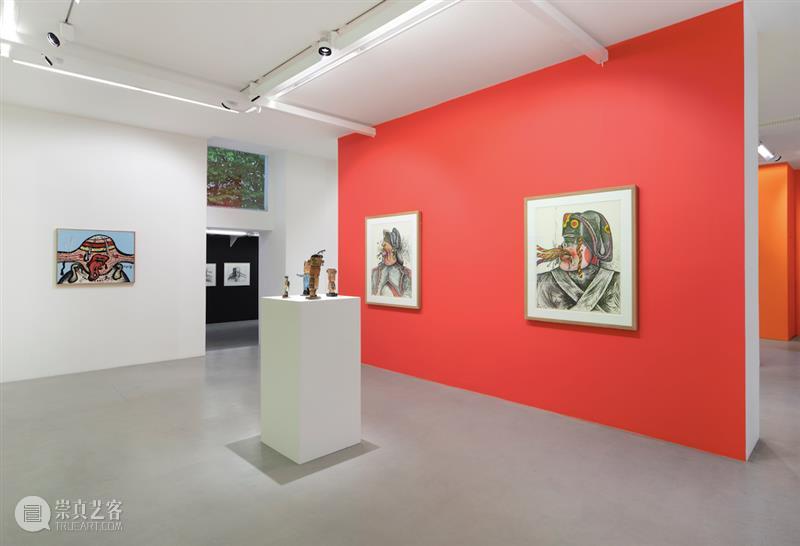
展览“马里安,一种绘画真相”现场,卡迈勒 · 梅隆赫画廊,2022Photo. archives kamel mennourCourtesy The Estate of Maryan and kamel mennour, Paris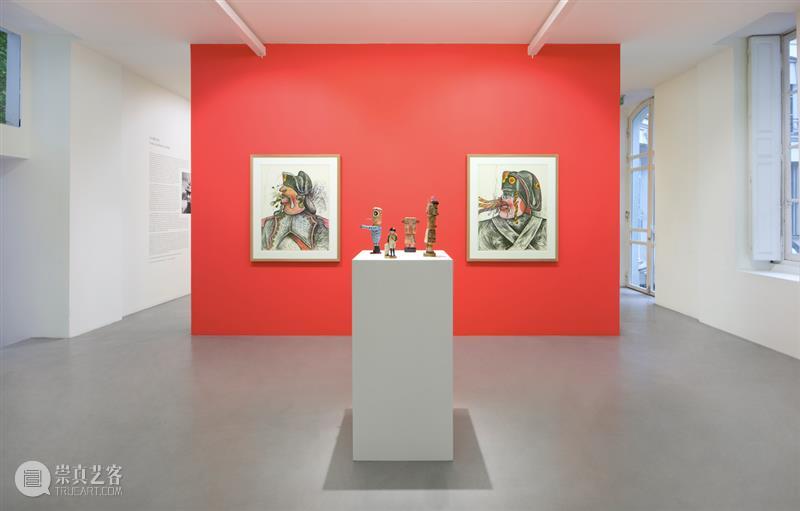
展览“马里安,一种绘画真相”现场,卡迈勒 · 梅隆赫画廊,2022Photo. archives kamel mennourCourtesy The Estate of Maryan and kamel mennour, Paris所有这些作品汇集成了一组令人惊叹的群像,这些色彩鲜明的肖像透着滑稽、讽刺和怪诞,人物们要么在喊叫、咧嘴、大笑、扮鬼脸,或者用糖果塞满嘴、呕吐、伸舌头,或者躲在面具背后甚至露出私密部位。马里安的绘画世界充满了奇奇怪怪且惹人喜爱的人物。在他的笔下,艺术如同人性一样,以一种既粗俗又崇高的方式展现给观者。他刻画的人物似乎来自一个充满冲突性的狂欢世界。我们仿佛置身一个盛大的节日,一场化妆舞会,或者用艺术家本人的话来说,一个令人难以置信的“人类动物园”。从这一点而言,马里安的画触及了我们最深刻最隐秘的部分。因为这些画面令人不安,带着挑衅又使人触动,提醒我们人类也是一种动物这一残酷事实,被困于充满矛盾且不断变化的情绪中无所适从。正如1978年在法兰西画廊举办的展览“向马里安致敬”中的一句话所言,他的作品展现的众多符号和故事构成了对“人类所有民俗活动的概括”。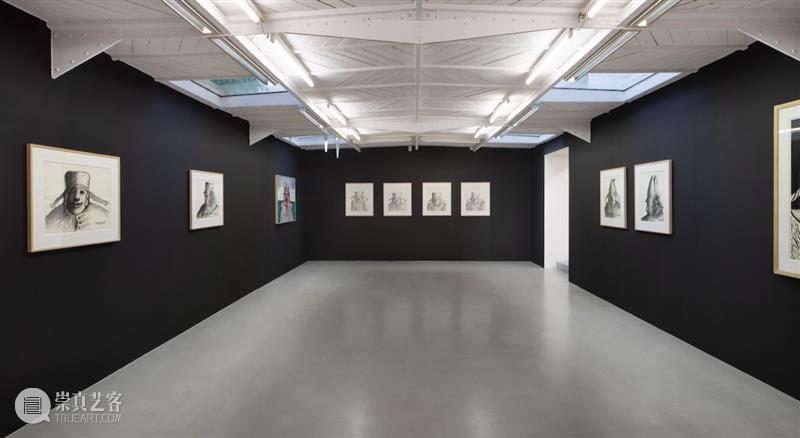
展览“马里安,一种绘画真相”现场,卡迈勒 · 梅隆赫画廊,2022Photo. archives kamel mennourCourtesy The Estate of Maryan and kamel mennour, Paris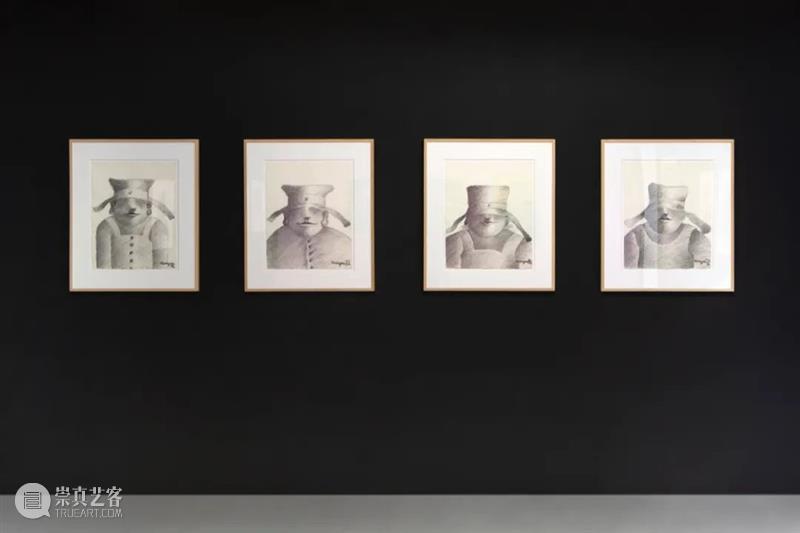
展览“马里安,一种绘画真相”现场,卡迈勒 · 梅隆赫画廊,2022Photo. archives kamel mennourCourtesy The Estate of Maryan and kamel mennour, Paris这些“民俗活动”来源多样,从马里安经常参观人类博物馆时看到的色彩斑斓的民俗服饰,到艺术家收藏的当时被称为“部落”艺术的艺术品。从巴黎到纽约,无论是酒店、公寓或临时停驻的地方,在马里安的生活空间里,物品占有着特殊的位置。1973年,他搬进了切尔西酒店。这间充满传奇色彩的酒店代表着纽约艺术界的蓬勃活力。从代理艺术家的画廊主艾伦·弗拉姆金于1977年拍摄的照片中我们可以一览艺术家的住所:这里充满了各种物品以及艺术品。他创造了自己的个人博物馆,在其中他的作品与来自世界各地的奇特物品进行着对话。波兰摇马玩具、日本产的电池驱动机器人、木偶、投币口香糖机、仪式和民俗面具、玛丽莲·梦露的海报、墨西哥陶瓷、迪斯尼小雕像、漫画、宗教偶像:所有这些物品组合在一起在美学上形成了一种绝对的不协调性,反倒催生了马里安的奇幻世界。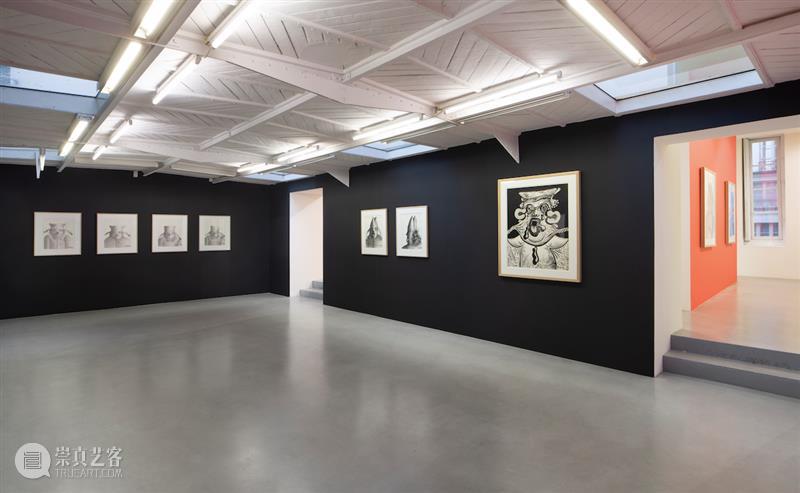
展览“马里安,一种绘画真相”现场,卡迈勒 · 梅隆赫画廊,2022Photo. archives kamel mennourCourtesy The Estate of Maryan and kamel mennour, Paris
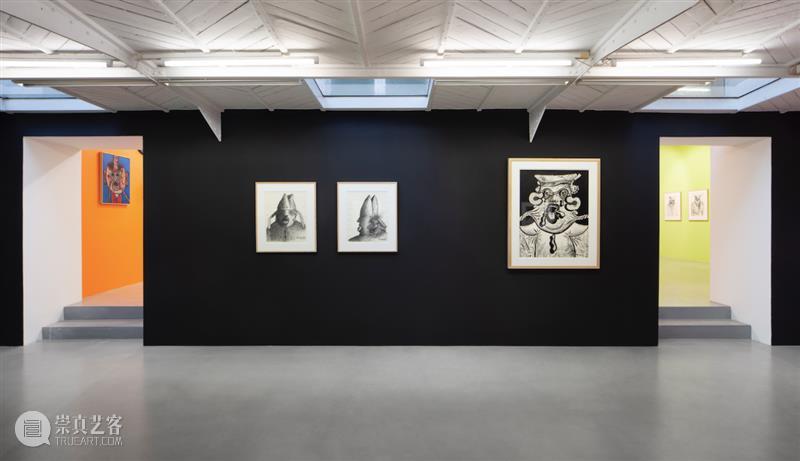
展览“马里安,一种绘画真相”现场,卡迈勒 · 梅隆赫画廊,2022Photo. archives kamel mennourCourtesy The Estate of Maryan and kamel mennour, Paris1977年6月15日,马里安在纽约公寓里因心脏病发作而逝世。他短暂的五十年生命,留下了一笔复杂同时又具有开创性的艺术遗产。他创造的世界、想象的人物和刻画的社会,是对他所经历的时代的独特记录。他对色彩的运用让人惊叹,对线条的把握无人能及,其作品所推动的绘画风格通过彼得 · 索尔、基思 · 哈林、罗伯特 · 康巴斯、菲利普 · 加斯顿等一批艺术家得以闻名。有些人从他的作品中看到了费尔南 · 莱热的影响,马里安曾在巴黎国立高等美术学院师从于他。他画作中又粗又厚的黑色线条,为爆炸性的色彩提供了框架,预示着涂鸦艺术的产生。从这个角度而言,马里安是一种真实而自由的绘画形式的先驱之一。其辨识度极高的笔法至今仍然影响着年轻一代的当代艺术家。马里安将这种表现主义的绘画形式称为“绘画-真相”。无论如何,在他的作品中,情绪使恐惧得以退去。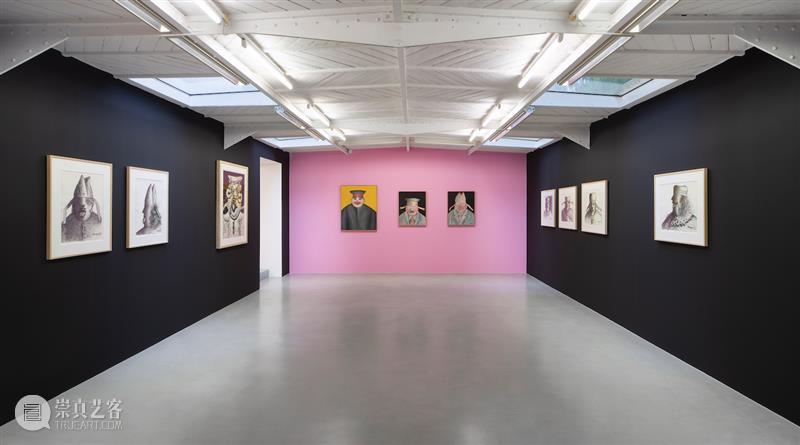
展览“马里安,一种绘画真相”现场,卡迈勒 · 梅隆赫画廊,2022Photo. archives kamel mennourCourtesy The Estate of Maryan and kamel mennour, Paris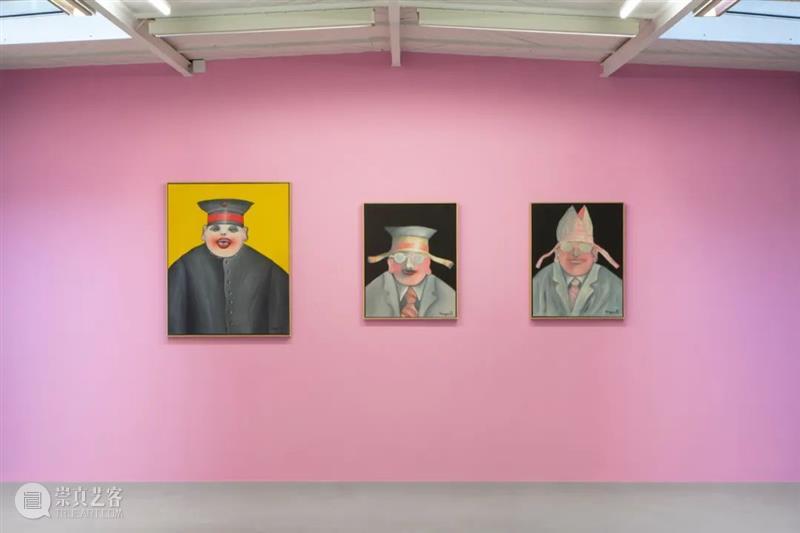
展览“马里安,一种绘画真相”现场,卡迈勒 · 梅隆赫画廊,2022Photo. archives kamel mennourCourtesy The Estate of Maryan and kamel mennour, Paris过去十几年来,众多国际文化机构真正认识到了他作品的价值,为他举办了一系列展览并出版书籍。2012年,安妮特 · M · 马里安向蓬皮杜艺术中心捐赠了50多幅作品,其中包括《拿破仑》系列的9幅素描。2013年,娜塔丽 · 哈赞-布鲁奈在犹太艺术与历史博物馆策划了马里安去世后在巴黎的首场回顾展。美国北迈阿密当代艺术博物馆目前正在举办的艺术家回顾展,将于2022年底在以色列特拉维夫艺术博物馆展出。卡迈勒 · 梅隆赫画廊选择在这里让我们重新认识这位新具象艺术运动的领军人物之一:一位在二十世纪逆流而上的艺术家。“谨将此次展览献给我的朋友安托尼奥 · 瑟盖(1934-2022),他是马里安的朋友,于今年2月26日去世。”
平查斯 · 伯恩斯坦(Pinchas Burstein)更广为人知的称呼是MARYAN S. MARYAN,于1927年出生于波兰新萨奇,1977年在纽约去世。他出生在一个犹太家庭,在二战期间被关入波兰的纳粹集中营,战争结束后又被送到德国的流离失所者收容营。他是全家唯一的幸存者。他从1947年到1950年住在耶路撒冷,期间在贝扎勒艺术与设计学院学习了两年,并于1949年在当地的基督教协会青年运动组织(Y.M.C.A)举办了首次个展。他于1950年移居法国,在法国国立高等美术学院学习,师从费尔南 · 莱热(Fernand Léger)。他1952年参加了巴黎的独立艺术沙龙(Salon des Surindépendants),1953年至1965年参加了五月沙龙(Salon de Mai)。1959年他获得巴黎双年展艺术评论奖。在法国生活了十二年后,他1962年移居纽约,并于1969年成为美国公民。1976年,他被授予法国艺术与文学骑士勋章。
他因心脏病发作于1977年6月15日在纽约切尔西酒店的公寓中去世,享年50岁。他留下的艺术遗产极具前卫性,意义巨大。他所创造的世界、塑造的人物以及通过夸张的风格所表现的种种符号和这个社会,构成了反映其时代的独特画面。
近年曾为马里安举办大型回顾展的机构包括美国芝加哥的斯佩特斯博物馆(1996)、巴黎犹太艺术与历史博物馆(2013)和北迈阿密当代艺术博物馆(2021)。他的作品被世界各地的重要机构收藏,包括:法国巴黎的蓬皮杜当代艺术中心、市立现代艺术博物馆和犹太艺术与历史博物馆,勒阿弗尔现代艺术博物馆,图尔宽博物馆,敦刻尔克当代艺术博物馆,奥贝里弗修道院当代艺术中心,格勒诺布尔博物馆、法国国家收藏;奥地利维也纳的路德维希基金会现代美术馆;德国的柏林国家博物馆和什未林美术馆;荷兰海牙市立博物馆;丹麦奥尔堡现代艺术博物馆;以色列特拉维夫艺术博物馆;美国纽约的现代艺术博物馆和古根海姆美术馆,匹兹堡卡内基美术馆,芝加哥的芝加哥艺术学院、 斯佩特斯博物馆和斯马特美术馆,华盛顿史密森尼学会,北迈阿密当代艺术博物馆。
Maryan
Une peinture vérité
Until 28 May 2022
47 rue Saint-André-des-Arts, Paris 6
With tribal artworks lent by the Galerie Flak and the Galerie Lucas Ratton
Born in 1927 to Polish Jewish parents in South-East Kraków, Pinchas Burstein was bound for a rough passage through the deadliest conflict of the twentieth century, which he was the only one of his family to survive. The artist who would later be known as Maryan S. Maryan left behind him a body of work whose chromatic and stylistic power were often seen to be a reflection of his own personal history in a sort of funhouse mirror. His artworks were not however a form of revenge on the events he had experienced, and he always refused to be seen through the unique prism of his time in the concentration camps. ‘Most of what people write about me is bogus,’ he wrote in the year he died. From his first exhibition in Jerusalem in 1949 to the moment of his sudden disappearance in 1977 in New York, Maryan used art as a vital cathartic tool. His work was without hatred but it was also not unperspicacious. He was not so much a painter of his own past, personal experience as that of the brutal, stirring fate of humanity. Though he was thought of by his peers as the father of New Figuration, his work was neglected for a long time. Maryan was neither an artist-witness nor a mad artist: the madness of his paintings stopped there. He was neither militant nor spokesman for a cause. Instead, he attempted to show the world as he saw it, as he experienced it, and most probably as it really is.In the 1950s, he lived in Paris, where abstraction reigned. He frequented the artists working in the scene at the time, from the École de Paris to Cobra, and out of his contact with them emerged what could be called ‘figurative expressionist’ paintings, in the footsteps of the French painter Jean-Michel Atlan and the Mexican painter Rufino Tamayo. In 1961, Mathias Fels organised the exhibition Nouvelle Figuration, in which he showcased the figurative movement that was developing in European painting at the time. Maryan’s works were exhibited alongside those of Karel Appel, Francis Bacon, Alberto Giacometti, and Jean Dubuffet.A new period began when Maryan went to the US in 1962 and took US citizenship in 1969, discovering the consumerist, American way of life. Abstract expressionism was falling out of favour and Pop Art was taking over. Maryan was highly attentive to this artistic movement, observing in all its details something that was not only taking place in the cultural sphere but was turning into a veritable social phenomenon. This discovery involved a major paradigm shift in his work. Maryan flourished in New York, developing a personal style imbued with multiple pop and folkloric influences. This original eclecticism would help him forge what became the distinctively recognisable ‘Maryanesque’ style.The paintings from this period—often untitled—represent solitary characters dressed in extravagant clothes, looking like they have been placed on stage for all the world to see. Though many of them are anonymous and unidentified, it’s possible to discern self-portraits in some, hiding behind big pairs of sunglasses. The swarm of characters includes members of the Klu Klux Klan (this white supremacist secret society was undergoing a resurgence in the 1960s), unknown men dressed in suit and tie (Wall Street bankers or businessmen), mouths stuffed with candy canes, and laughing, mocking faces. Some of them are wearing dunce’s hats, others have hair falling down into their eyes. Their hats—bowler hats, pointed hats, battered, out of shape, oversized hats—are distant echoes of those of the Penitents of Seville. They are also reminiscent of the works of Velázquez, Francisco de Goya, and Frans Hals, all of whom Maryan admired. While they offer a biting satire of contemporary society, these works seem above all to have originated in the artist’s everyday life, and in unexpected aesthetic shocks, like the series of characters disguised as Napoleon (based on a statuette of the Emperor that a collector friend gave to him), or like the surprising corrida scenes he painted after spending time in Spain, in which the executioner can be seen facing his victim.All of this comes together to form an amazing gallery of quirky, caricatural, grotesque, colourful portraits, with subjects who shout, grin, laugh, grimace, stuff themselves with sweets, vomit, stick their tongue out, hide behind masks, or expose their genitals. Maryan’s pictorial world is full of strange and strangely endearing characters. Under his brush, art takes its measure from humanity, showing itself to the viewer in a way that is both trivial and grandiose. On display is one big festival, a fancy-dress party, an incredible ‘human menagerie’, to use the artist’s own expression. In this, Maryan’s painting reaches into the most profoundly intimate parts of ourselves. It is disturbing, provocative, and tender, reminding us of the cruel fact that humans are animals, drawn and quartered over our contrary, changing emotions. The multitude of symbols and stories that his body of work puts on display constitute a ‘synthesis of the all the mass manifestations of humanity’, as was said on the occasion of the 1978 exhibition Hommage à Maryan at the Galerie de France.These ‘mass manifestations’ are drawn from an incredible array of sources, from the shimmer of the folkloric costumes Maryan will have seen during his frequent visits to the Musée de l’Homme, to the angular lines of what was then known as ‘tribal’ art, which he collected. From Paris to New York, in Maryan’s living spaces—places of transit, hotels and apartments—objects hold a special place. In 1973, he moved into the mythic Chelsea Hotel, nerve centre of the vibrant New York arts scene. His apartment can be seen in the photos taken by his dealer Allan Frumkin in 1977. It overflows with heteroclite objects and works of art. He created his own personal museum in which his own creations sat side by side with strange objects from around the world. A Polish rocking horse, a Japanese battery-powered robot, wooden puppets, chewing-gum distributors, ritual and mass market masks, a poster of Marilyn Monroe, Mexican ceramics, Disney figurines, comics, religious icons: this impressive collection in its absolute aesthetic disparity was the fertile ground from which Maryan’s fantastic universe emerged.On the 15th of June 1977, Maryan had a heart attack in his New York apartment at age fifty, leaving behind him a complex, aesthetically pioneering artistic legacy. The universe he created, the characters he invented, the society he caricaturised represent so many unique images of the time he lived through. He was an amazing colourist, an unparalleled drawer, contributing to the development of a pictorial style that today has become famous through the works of artists like Peter Saul, Keith Haring, Robert Combas, and Philip Guston. Some have seen in his work the legacy of Fernand Léger, whom he studied under at the École Nationale Supérieure des Beaux-Arts de Paris. The big, thick black lines of his paintings, the way they hold in explosive sections of colour, anticipates contemporary graffiti. Maryan is for this one of the precursors of a free, true form of painting whose identifiably efficient graphic line still influences the younger generations of contemporary artists. Maryan called this expressionist form of painting ‘truth-painting’. Undeniably, in his work the emotions push horror back.For the last fifteen years, international cultural institutions have been giving his work the attention it deserves in a series of exhibitions and publications. In 2012, Annette M. Maryan donated about fifty works to the Pompidou Centre, including nine drawings from the Napoléon series. In 2013, for the Musée d’Art et d’Histoire du Judaïsme (MAHJ), Nathalie Hazan- Brunet curated the first retrospective dedicated to his work in Paris since his death. The Museum of Contemporary Art North Miami (MOCA) is currently exhibiting a retrospective that will go on show at the Tel Aviv Museum of Art at the end of 2022. Kamel Mennour has chosen to reintroduce us here to the work of one of the leaders of New Figuration, an artist who swam against the tide of the twentieth century.For my friend Antonio Seguí (1934-2022), a friend of Maryan’s who passed away on the 26th of February.——Lucas Djaou, curator of the exhibition
Born in 1927 in Nowy Sacz (Poland), Pinchas Burstein, known as MARYAN S. MARYAN, died in 1977 in New York. He was born into a Jewish family. During World War II he was deported to Nazi concentration camps in Poland and then at the end of the war to displaced persons camps in Germany. He was the only survivor of his family. He lived in Jerusalem from 1947 to 1950 where he attended the Bezalel Academy of Art and Design for two years. His first solo exhibition took place in 1949 at the Youth Movement of Christian Association (Y.M.C.A) in Jerusalem. He moved to France in 1950 where he studied at the École Nationale Supérieure des Beaux‐Arts (E.N.S.B.A) and attended classes with Fernand Léger. In 1952 he participated in the Salon des Surindépendants and from 1953 to 1965 in the Salon de Mai in Paris. In 1959, he was awarded the Art Critics Prize at the Paris Biennale. After living in France for twelve years, he moved to New York in 1962 and became a U.S. citizen in 1969. In 1976, he was awarded the Chevalier de l’Ordre des Arts et des Lettres in France.Maryan died prematurely on June 15, 1977, at the age of 50 of a heart attack in his apartment in the Chelsea Hotel in New York. He left behind a meaningful avant-garde artistic legacy. The universe he created, the characters he invented, the symbols and the society he caricaturised are absolutely singular images of the time he lived through.Several important retrospectives have been dedicated to Maryan, including at the Spertus Museum (Chicago, USA) in 1996, at the Musée d’art et d’histoire du Judaïsme (mahJ) (Paris) in 2013 and at the Museum of Contemporary Art North Miami (MOCA) in 2021.His works are part of prestigious collections around the world: the Centre Pompidou (Paris), the Museum of Modern Art in Paris, the Museum of Jewish Art and History (mahJ) (Paris), the MuMa (Le Havre, France), the Museum of Tourcoing (France), the LAAC - Lieu d’Art et d’Action Contemporaine (Dunkerque, France), the Centre d’Art Contemporain de l’abbaye d’Auberive (France), the Museum of Grenoble (France), the Collections de l’État Français, the mumok (Vienna, Austria), the Staatliches Museum (Berlin, Germany), the Staatliches Museum Schwerin (Germany), the Municipal Museum of The Hague (Netherlands), the Kunsten - Museum of Modern Art Aalborg (Denmark), the Tel Aviv Museum of Art (Israel), the MoMA (New York), the Guggenheim Museum (New York) the Carnegie Museum of Art (Pittsburgh, USA), the Art Institute of Chicago (USA), the Spertus Museum (Chicago, USA), the David and Alfred Smart Museum of Art (Chicago, USA), the Smithsonian Institution (Washington, USA), the Museum of Contemporary Art North Miami (MOCA).
 The Estate of Maryan 47, rue Saint-André-des-Arts, Paris 6
The Estate of Maryan 47, rue Saint-André-des-Arts, Paris 6 Camille Henrot 5, rue du Pont de Lodi, Paris 6
Camille Henrot 5, rue du Pont de Lodi, Paris 6
 Carte blanche - Camille Henrot, Elisabeth Jaeger & Estelle Hoy 5, rue du Pont de Lodi, Paris 6
Carte blanche - Camille Henrot, Elisabeth Jaeger & Estelle Hoy 5, rue du Pont de Lodi, Paris 6

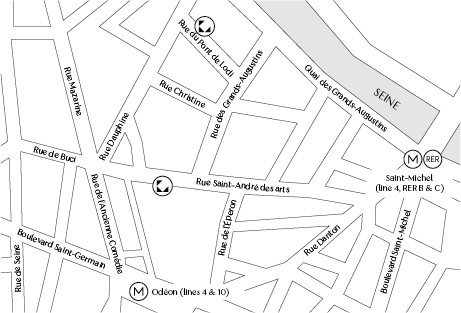
47, rue Saint‑André‑des‑Arts
75006 Paris
France
&
5 & 6, rue du Pont de Lodi
75006 Paris
France
+33 1 56 24 03 63
识别二维码,关注画廊官方微信
点击阅读原文,进入画廊官方网站
如需转载,请注明出处
 Website: www.kamelmennour.com
Website: www.kamelmennour.com
 WeChat: kamel_mennour
WeChat: kamel_mennour Facebook: kamel mennour
Facebook: kamel mennour Instagram: kamelmennour
Instagram: kamelmennour
 E-mail: galerie@kamelmennour.com
E-mail: galerie@kamelmennour.com
{{flexible[0].text}}

 {{newsData.good_count}}
{{newsData.good_count}}

 {{newsData.transfer_count}}
{{newsData.transfer_count}}


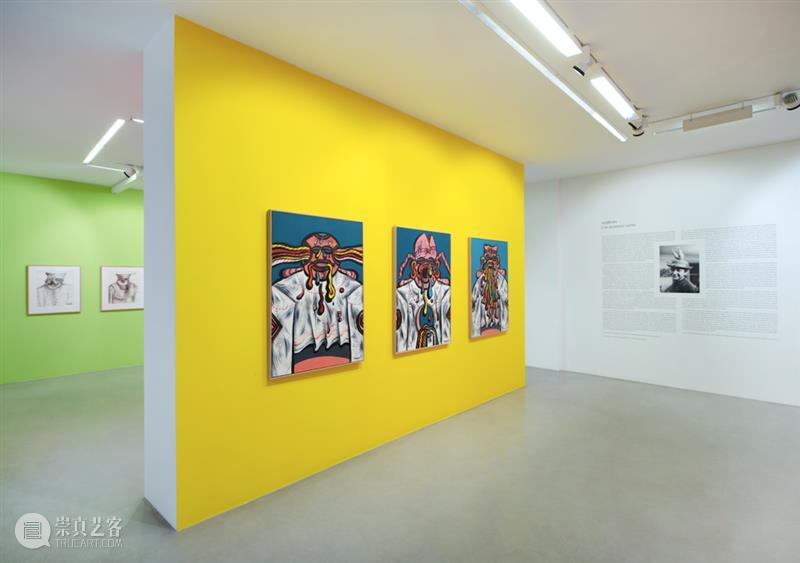


















The Estate of Maryan
Camille Henrot
Carte blanche - Camille Henrot, Elisabeth Jaeger & Estelle Hoy
Website: www.kamelmennour.com
WeChat: kamel_mennour
Facebook: kamel mennour
Instagram: kamelmennour
E-mail: galerie@kamelmennour.com










 分享
分享